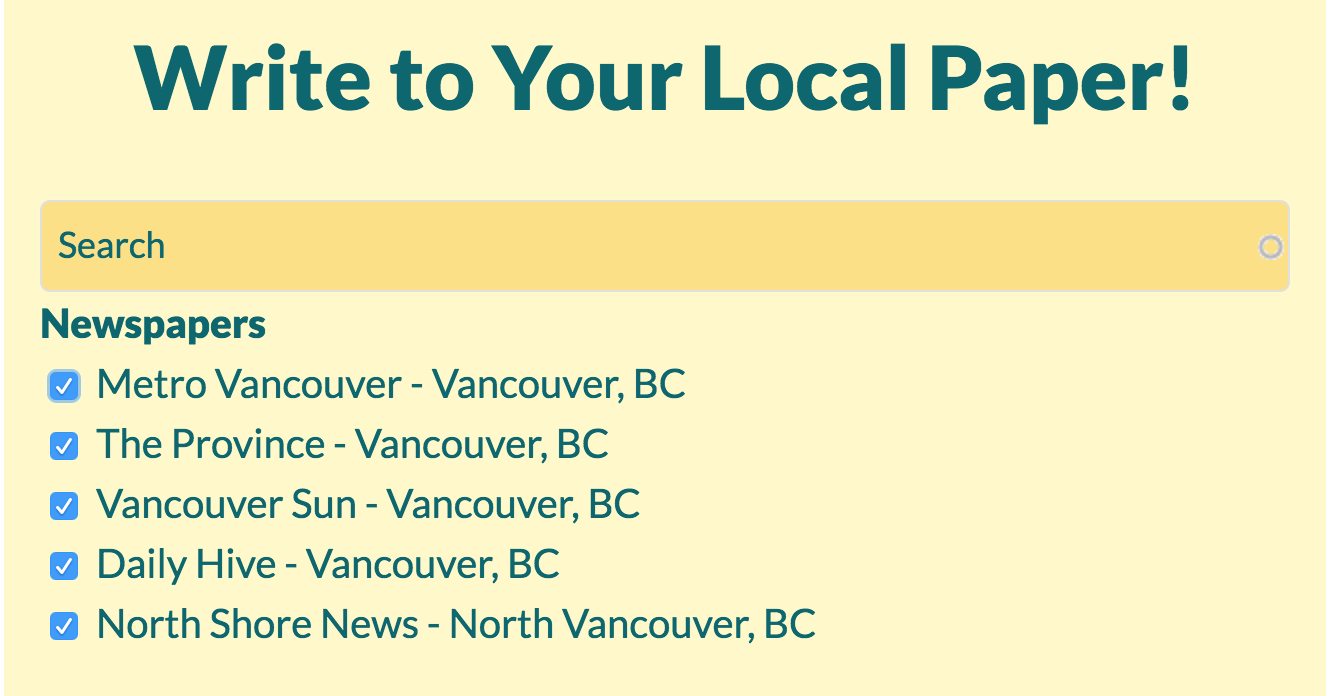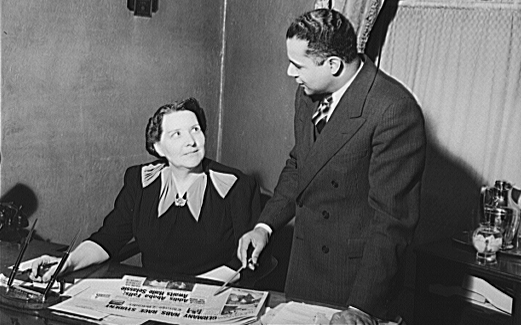Asking your supporters to write a letter to their local paper is a big ask, but when it comes through, it's also a big, BIG win.
Learn how to set up, manage, and get the most out of your LTE Action.
Our Letters to the Editors Action works by connecting supporters to their local papers. When letter writers provide a postal code, our databases automatically connect to their most relevant nearby publications.
Guide Your Supporter
All that an LTE Action needs to start working is a zip/postal code. After entering their zip code on Page 2, supporters will see a list of local papers from which they can choose to submit:

Options for displaying publications:
- By default we show five newspaper results. You can increase this number under Advanced>Components>Edit Newspapers
- You can include a search bar that allows supporters to look up and target publications outside of their immediate area.
Key Points and Content
Unlike an Emailing or Petition Action, an LTE Action thrives on original content. You want to do everything possible to encourage supporters to write their own letters. That makes the Key Points section of the action form essential. By default, Key Points will appear below the letter field on the second page of the action.
Instead of including key points that can be easily copied and pasted into the letter, try using this space to ask questions that inspire readers to share their own experiences. A great story is important to the success of a compelling letter. Questions like:
1. How does this issue affect you personally?
2. What change would you like to see made?
3. Does this affect people you know?
You can also add guidelines in the message content instead of a form letter. For example:
[As a nurse/worker/teacher, this is important to me because......]
[I would like Congress to take action on this because.....]
[My health/income/mental health will be threatened by this legislation because.....]
Attract Editors

Newspaper editors are constantly on the lookout for relevant new content. Once you've got supporters sharing unique, personal stories, you also want to design and manage your LTE Action in a way that appeals to news publications. Some strategies to consider include:
-
Write multiple email subject lines and randomize them so that letters look like an interested individual is just spontaneously emailing the editor. The more subject lines you provide, the better. You don't want editors seeing the same subject line appearing over and over again in their inbox!
-
Always ask for your supporter's full name on your form. Anonymous articles are extremely unlikely to get published!
-
Whenever you send a reminder email blast for supporters who have yet to write a letter, change up the key points on the action so that new waves of letters will be fresh and relevant.
-
Monitor and review the letters being sent! We always recommend leaving Auto-Approval OFF under Basic Configuration for LTE campaigns.
- Let the letters trickle out. Particularly for campaigns that are targeting a small cluster of publications, you might not want those publications to get slammed with an avalanche of letters on the same day and even at the same time. To give the sent letters a more organic flow, release them gradually over an extended period of time. You can use the PENDING setting under the Submissions tab to tag letters that you've approved but don't yet want to send out.
Letter to the Editor Guidelines from The Washington Post
To give you a better idea of what editors appreciate, these are recommendations from editors at The Washington Post about the letters they like to receive:
- We prefer letters that are fewer than 250 words and take as their starting point an article or other item appearing in The Post.
- They may not have been submitted to, posted to or published by any other media.
- They must include the writer's full name; anonymous letters and letters written under pseudonyms will not be considered.
- For verification purposes, they must also include the writer's home address, email address and telephone numbers, including a daytime telephone number.
- Writers should disclose any personal or financial interest in the subject matter of their letters.
- If sending an email, please put the text of the letter in the body and do not send attachments; attachments will not be read.
Build on Your Success
One of the keys to what we at New/Mode call full spectrum engagement is giving recognition to the supporters who take the time and effort to contribute to a campaign. No victory is too small to merit a celebration, so when a supporter gets a letter published, let your network know about it!

Celebrating campaign success stories is also a great justification for a follow-up email blast to your supporters. Not only is it a chance to remind them about the campaign, it's an opportunity to demonstrate that your strategy is working - if they take the time to add their voices to your campaign, they will be heard! Change is possible!
Paying careful attention to what supporters are writing can also help you hone and sharpen the focus of your platform. Use supporter letters - even those that don't get published - to gauge what resonates with your community. For example, an anti-pipeline campaign might focus on issues including Indigenous rights, the environmental dangers of pipeline development, risks related to spills, accidents, and malfunctions, or the long-term untenability of our continued reliance on fossil fuels. What do your supporters care about?
As this article suggests, the Letters to the Editors Action really benefits from a bit of care and attention. Like a hothouse flower, regular maintenance and grooming may be essential to success, but the result will be a spectacular bloom of grassroots engagement, media visibility, and loud, proud community ownership of campaign progress!
Last updated: August 10, 2023
